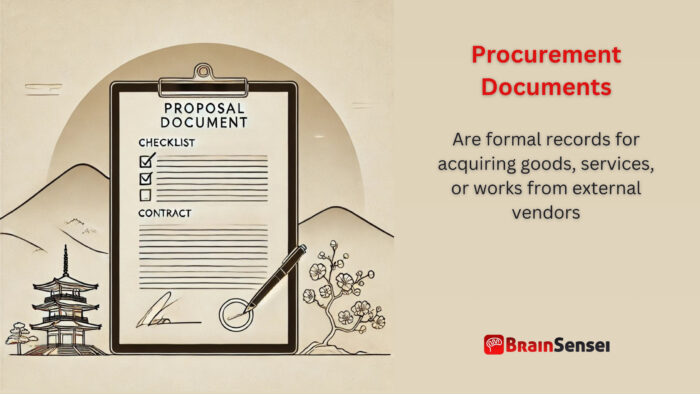
Procurement Documents
What are Procurement Documents?
Procurement documents are formal records for acquiring goods, services, or works from external vendors. They define procurement activities’ terms, scope, requirements, and conditions and ensure project management transparency, compliance, and efficiency.
Key Takeaways
- Procurement documents facilitate structured acquisition processes.
- They establish clear expectations and accountability between buyers and suppliers.
- These documents include requests for proposals (RFPs), contracts, purchase orders, and bid documents.
- They help mitigate risks by setting legal and financial terms upfront.
- Proper procurement documentation supports auditability and compliance with regulatory requirements.
Understanding Procurement Documents
How Procurement Documents Work
Procurement documents serve as communication tools between buyers and vendors. They outline specific requirements, evaluation criteria, and contractual obligations to ensure clarity and mutual understanding.
Key types of procurement documents include:
- Request for Proposal (RFP): Solicits detailed proposals from potential suppliers for complex projects.
- Request for Quotation (RFQ): Requests pricing and details for standardized goods or services.
- Invitation to Bid (ITB): Calls for competitive bidding, usually in government and large-scale projects.
- Statement of Work (SOW): Defines a project’s scope, deliverables, and deadlines.
- Purchase Order (PO): A formal order issued to a supplier confirming the purchase.
- Contract Agreement: Legally binds the buyer and supplier under agreed terms and conditions.
Notes
- Procurement documents should align with organizational procurement policies and legal frameworks.
- Clear and precise documentation minimizes misunderstandings and disputes.
- Standardized templates improve efficiency and consistency.
- Digital procurement platforms help streamline document management.
- Regular reviews ensure compliance with changing regulations and industry best practices.
Related Terms
Understanding procurement documents involves familiarity with related procurement and contract management concepts:
- Procurement Management Plan: A strategic document outlining procurement procedures and policies and guiding the organization’s purchasing activities.
- Vendor Evaluation Criteria: Standards used to assess supplier capabilities and performance.
- Contract Lifecycle Management (CLM): The systematic handling of contracts from initiation to renewal.
- Bid Evaluation Process: The method used to assess and compare supplier bids.
- Procurement Audit: A review process ensuring compliance with procurement policies and regulations.
- Supply Chain Management (SCM): The strategic coordination of all activities involved in the flow and transformation of goods from raw materials to consumers.
Examples of Procurement Documents in Different Industries
Construction Industry
A large construction company is planning a new commercial building project. Before selecting vendors and subcontractors, the procurement team issues several procurement documents to streamline the process. First, the project team sends an RFP to engineering firms and suppliers for materials like steel, cement, and electrical wiring. Vendors submit their proposals, detailing costs, delivery schedules, and compliance with industry standards. Simultaneously, an RFQ is used to gather price quotations for bulk purchases of standard construction materials.
The project team reviews the proposals and quotations and then issues an ITB for subcontractors, inviting bids from companies specializing in plumbing, electrical work, and carpentry. They evaluate each bid against cost, timeline, and quality assurance criteria. After selecting vendors, they issue purchase orders, ensuring each supplier delivers materials on schedule. The final contract agreements include warranties, penalty clauses for delays, and scope of work expectations.
Healthcare Industry
A hospital is upgrading its medical equipment, requiring high-quality MRI scanners and patient monitoring systems. The procurement department drafts an RFQ and requests detailed pricing and specifications from multiple medical device manufacturers. Because the equipment must comply with health and safety regulations, the hospital prepares an SOW specifying installation requirements, maintenance schedules, and training support for hospital staff.
After receiving quotations and assessing vendor qualifications, an RFP is sent to shortlisted companies to provide comprehensive proposals, including case studies, performance guarantees, and service agreements. The proposals are reviewed based on compliance, price competitiveness, and after-sales support. Once a vendor is selected, a contract agreement is signed to ensure compliance with regulatory standards, define warranty periods, and set up payment terms. Purchase orders are then issued, confirming the hospital’s commitment to procurement and delivery schedules.
IT & Software Industry
A software firm is in the process of selecting a cloud-based project management solution to enhance internal workflow. The procurement team begins by drafting an RFP, outlining software requirements, security protocols, integration capabilities, and budget constraints. Various software vendors submit proposals detailing product functionality, subscription models, and support services.
An RFQ is also sent to shortlisted vendors for the best pricing options, requesting specific price breakdowns based on different subscription tiers and licensing models. A vendor evaluation criteria document also assesses providers based on reliability, cybersecurity measures, and scalability. After careful review, the company selects a vendor. It issues a contract agreement that includes terms of service, data privacy clauses, and service-level agreements (SLAs) for uptime and technical support.
Retail Industry
A multinational retail chain is expanding its stores and needs to procure new point-of-sale (POS) systems. The procurement team sends an ITB to technology providers, asking for bids that meet technical specifications, cost efficiency, and scalability needs. Multiple vendors respond with detailed proposals, and the procurement team evaluates bids to identify the best match.
After selecting a vendor, the company issues a purchase order that specifies the hardware quantity, software licenses, and delivery deadlines. To guarantee a smooth implementation, the company also signs a contract agreement that details service warranties, training sessions for store employees, and compliance with data security regulations.
Aerospace Industry
An aerospace manufacturer is sourcing avionics systems for a new commercial aircraft. Given the complexity of procurement in this industry, the project team initiates a multi-stage procurement process. First, an RFP is sent to aerospace technology providers, outlining performance requirements, safety certifications, and integration with existing aircraft systems. Vendors submit proposals detailing engineering capabilities, research and development investments, and long-term maintenance plans.
An RFQ is issued to gather price breakdowns for hardware, software, and long-term service contracts to finalize costs. A statement of work is prepared to ensure each supplier understands compliance with aviation safety regulations. Once a vendor is selected, a contract agreement establishes intellectual property rights, delivery milestones, and performance penalties for non-compliance.
These examples illustrate how procurement documents are crucial industries, ensuring transparency, compliance, and efficiency in acquisition processes.
Use Cases of Procurement Documents Application
Canada (Government Procurement)
A Canadian municipality aims to improve its public transportation system by introducing electric buses. The city council releases an ITB, inviting manufacturers to submit bids detailing vehicle specifications, pricing, warranty terms, and delivery schedules. After evaluating multiple bids based on cost, environmental impact, and efficiency, the city awards a contract to the best-qualified supplier. Then, a contract agreement is signed detailing responsibilities, penalties for late deliveries, and compliance requirements for public transportation infrastructure.
Additionally, the procurement department issues a purchase order to the selected manufacturer, specifying the exact number of buses, agreed pricing, and payment terms. A statement of work (SOW) outlines the expected production, testing, and deployment timeline. The project is monitored through regular procurement audits to ensure the supplier adheres to the agreement.
Germany (Manufacturing)
A German car manufacturer is expanding its electric vehicle production and requires high-performance lithium-ion batteries. The company issues an RFP to multiple battery suppliers, specifying energy efficiency, durability, and cost requirements. Vendors submit comprehensive proposals that include their production capabilities, testing results, and sustainability certifications.
After conducting a thorough bid evaluation process, the manufacturer selects a supplier that meets technical and economic criteria. The company then signs a contract agreement outlining the terms of supply, warranty conditions, and penalties for quality defects or delays. The company also issues an RFQ to logistics providers to manage the transportation of batteries from the supplier’s plant to the car assembly facility.
Throughout the contract lifecycle, the procurement team continuously assesses vendor performance using vendor evaluation criteria to ensure compliance with specifications and industry regulations. The team also conducts regular procurement audits to verify safety and environmental standards compliance.
India (Telecommunications)
A major telecom company in India is expanding its fibre optic network across urban and rural areas. The company releases an RFP to fibre optic cable manufacturers, requesting proposals that include cost breakdowns, technical specifications, and estimated project timelines.
Following the proposal review, the project team issues an ITB to construction firms that lay fibre optic cables. The company evaluates bids based on experience, cost-effectiveness, and project completion times. Once the best contractor is selected, the project team signs a contract agreement detailing the scope of work, safety requirements, and government compliance regulations.
The procurement team issues purchase orders for bulk purchases of cables, connectors, and networking hardware to streamline supply chain logistics. The team monitors the project through procurement audits to ensure vendors meet the requirements.
Additionally, the company establishes a contract lifecycle management strategy to ensure network reliability and maintenance agreements for post-installation support and future expansions.
Saudi Arabia (Energy Sector)
A solar energy company in Saudi Arabia is developing a large-scale photovoltaic farm. The procurement team issues an RFP to solar panel manufacturers, seeking vendors that can provide high-efficiency panels suitable for extreme climate conditions. The submitted proposals are evaluated based on efficiency, durability, pricing, and warranties.
After selecting a supplier, the team signs a contract agreement outlining delivery schedules, installation support, and quality control measures. An ITB is sent to engineering and installation firms to manage construction, inviting competitive bids. Once the installation team is chosen, the project manager prepares a statement of work (SOW) specifying deadlines, environmental impact assessments, and safety guidelines.
To ensure smooth logistics, the procurement department issues purchase orders for essential components such as inverters, mounting systems, and grid connections. They also implement contract lifecycle management (CLM) to guarantee long-term system maintenance and performance monitoring service agreements.
South Africa (Pharmaceutical Industry)
A pharmaceutical company in South Africa is expanding its vaccine production capacity. To acquire advanced bioreactors and sterile manufacturing equipment, the company issues an RFQ to leading suppliers in the industry. Shortlisted vendors provide quotations with specifications, pricing, and lead times.
Once the procurement team finalizes the supplier selection, a contract agreement covers warranty terms, compliance with Good Manufacturing Practices (GMP), and after-sales support. Additionally, the company issues an RFP for logistics providers to ensure safe and temperature-controlled transportation of raw materials and finished products.
The procurement team audits suppliers regularly to ensure they meet regulatory and safety requirements. The team also uses vendor evaluation criteria to assess supplier performance, ensuring the facility operates efficiently and meets international pharmaceutical standards.
These use cases illustrate how procurement documents are vital in managing vendor relationships, ensuring regulatory compliance, and optimizing operational efficiency across diverse industries.
Best Practices for Effective Procurement Documents
Ensuring adequate procurement documentation requires adherence to several best practices. Procurement processes often involve multiple stakeholders, compliance regulations, and legal considerations. Below are key best practices organizations should follow to optimize procurement documentation:
Develop Clear and Detailed Procurement Documents
A fundamental best practice is ensuring that procurement documents are clear, comprehensive, and free of ambiguity. Clearly stating requirements, pricing structures, evaluation criteria, and contract terms prevents misunderstandings and disputes. Using standardized templates and checklists can help ensure consistency across procurement activities.
Standardize Procurement Documentation Processes
Establishing a standardized approach to procurement documentation streamlines workflows and enhances efficiency. Organizations should implement standardized templates for RFPs, RFQs, ITBs, and contracts to maintain uniformity and reduce errors. Additionally, creating internal procurement guidelines helps employees understand documentation procedures and regulatory requirements.
Leverage Digital Procurement Platforms
With technological advancements, digital procurement tools offer automation, tracking, and document management capabilities. Implementing an e-procurement system ensures that procurement documents are stored securely, easily accessible, and systematically organized. Digital platforms reduce paperwork, enhance collaboration between procurement teams and vendors, and facilitate real-time updates.
Ensure Regulatory and Compliance Alignment
Procurement documentation must align with legal and regulatory requirements, including industry standards, environmental policies, and labour laws. Failure to comply with procurement regulations can result in legal disputes, financial penalties, and reputational damage. Organizations should conduct regular compliance audits to ensure adherence to procurement policies and contractual obligations.
Establish Robust Evaluation and Approval Processes
A well-defined procurement evaluation process ensures organizations select vendors based on objective criteria rather than subjective preferences. Organizations should implement formal bid evaluation frameworks, scoring mechanisms, and approval workflows to maintain transparency and fairness in procurement decisions.
Conduct Vendor Performance Reviews
Beyond issuing procurement documents, organizations should continuously assess vendor performance through structured performance review mechanisms. Key performance indicators (KPIs) such as delivery timelines, quality standards, and contract adherence should be monitored to ensure vendors meet expectations. Establishing a formal vendor feedback system fosters long-term supplier relationships and continuous improvement.
Integrate Risk Management into Procurement Documentation
Procurement activities involve risks, including supplier failure, cost overruns, and contract disputes. Organizations should integrate risk assessment measures into procurement documents, including penalty clauses for non-compliance, alternative supplier provisions, and insurance requirements. A structured risk management approach minimizes disruptions and financial losses.
Regularly Review and Update Procurement Documents
Procurement policies and regulations evolve, necessitating periodic reviews of procurement documents. Organizations should establish a document review schedule to update outdated policies, terms, and conditions. Involving legal and procurement experts in this review process ensures that procurement documents comply with changing regulations.
Train Procurement Teams on Documentation Best Practices
Procurement professionals should undergo regular training to stay updated on best practices in procurement documentation. Training sessions should cover contract management, compliance requirements, bid evaluation methodologies, and digital procurement tools. An informed procurement team enhances efficiency, reduces errors, and ensures proper documentation management.
Enhance Transparency and Accountability
Transparent procurement documentation fosters trust between organizations and vendors. The procurement team implements a procurement audit trail to ensure they correctly record all procurement decisions, approvals, and changes. Organizations should also provide clear justifications for vendor selections to promote fairness and accountability.
By adopting these best practices, organizations can significantly improve procurement efficiency, reduce risks, and ensure compliance with industry regulations. A well-structured procurement documentation process enhances operational effectiveness, mitigates financial and legal risks, and fosters strong vendor relationships.
Procurement Documents: Common Mistakes and Issues
Procurement processes are complex, and even minor mistakes in documentation can lead to legal disputes, financial losses, and project delays. Below are some of the most common mistakes organizations make in procurement documentation, along with their consequences and prevention strategies.
Lack of Clarity in Procurement Documents
One of the most frequent mistakes in procurement documentation is vague language. Poorly defined contract terms, ambiguous scope descriptions, and inconsistent requirements can lead to vendor misinterpretation. For example, if a procurement document does not specify the delivery schedule, suppliers may assume different timelines, resulting in project delays. To prevent this, procurement teams should use standardized templates, provide detailed specifications, and review all documents for accuracy.
Inadequate Risk Assessment and Contingency Planning
Many organizations fail to integrate risk assessment and contingency planning into their procurement documentation. Contracts should outline risk mitigation strategies, penalty clauses for non-compliance, and alternative supplier provisions in case of vendor failure. Organizations may struggle to address supply chain disruptions or legal disputes without these provisions.
Ignoring Compliance and Regulatory Requirements
Procurement processes must adhere to legal and regulatory standards, such as labour laws, environmental policies, and financial regulations. Failing to include compliance clauses in procurement documents can result in legal challenges and monetary penalties. Organizations should ensure that procurement documentation references applicable laws and undergoes legal review before issuance.
Poor Vendor Selection Criteria
Selecting a vendor solely based on price rather than evaluating quality, reliability, and reputation can lead to subpar performance. Procurement processes should include a well-defined vendor evaluation criteria document outlining assessment factors such as past performance, industry certifications, and financial stability. Companies that fail to implement structured evaluation processes may have unreliable suppliers.
Incomplete or Missing Documentation
Missing procurement documents such as purchase orders, contract agreements, and change order requests can confuse and hinder accountability. For example, if an organization fails to issue a formal purchase order, the supplier may not deliver goods on time or at the agreed price. Proper documentation ensures transparency and serves as a legal reference in disputes.
Failure to Review and Update Procurement Policies
Procurement policies and regulations evolve, and failing to update procurement documents accordingly can lead to non-compliance. Therefore, it is crucial to regularly review procurement documentation and incorporate updates based on industry standards, market trends, and regulatory changes to ensure effective procurement management.
Overlooking Contract Lifecycle Management (CLM)
Contract lifecycle management (CLM) is essential for maintaining long-term supplier relationships and tracking contract performance. Organizations that neglect contract monitoring may encounter expired agreements, unnoticed renewal clauses, or breach of contract issues. Implementing a contract management system allows procurement teams to track milestones, compliance requirements, and renewal deadlines.
Lack of Transparency and Accountability
Procurement documentation should foster transparency by clearly recording decisions, approvals, and contract modifications. However, organizations may sometimes fail to maintain a proper audit trail, leading to disputes over project scope or budget changes. The team establishes procurement audit trails to ensure they document all procurement actions and can review them for accountability.
Inadequate Communication with Stakeholders
Another critical issue in procurement documentation is poor communication between internal teams and external vendors. Procurement documents should facilitate smooth communication by clearly defining responsibilities, deliverables, and expectations. Organizations should ensure all stakeholders can access updated procurement documents and provide training on procurement policies.
Ignoring Performance Metrics and KPIs
Procurement success should be measurable, and procurement documents should define key performance indicators (KPIs) to evaluate vendor performance. Ignoring performance tracking can lead to repeated issues with supplier reliability, product quality, or cost overruns. Procurement teams should implement structured performance review processes and include KPI tracking mechanisms in procurement contracts.
Addressing these common procurement documentation mistakes can improve procurement efficiency, minimize risks, and enhance vendor relationships. A proactive approach to procurement management, including regular document reviews, stakeholder communication, and compliance monitoring, ensures smoother procurement operations and successful project outcomes.
Procurement Documents: Frequently Asked Questions (FAQs)
What is the purpose of procurement documents?
Procurement documents provide a structured approach to acquiring goods and services, ensuring legal compliance, cost control, and vendor accountability.
How do procurement documents differ from contracts?
Procurement documents include various records (RFPs, RFQs, POs) used in the acquisition process, while contracts are legally binding agreements between parties.
What should a company include in a procurement document?
A procurement document should outline the scope of work, requirements, pricing, evaluation criteria, and contractual terms.
Why are procurement documents important in project management?
They help manage risks, maintain transparency, and ensure they meet project requirements within budget and time constraints.
How can businesses improve procurement documentation?
Businesses can improve procurement documentation by using standardized templates, adopting digital procurement tools, and ensuring regular compliance audits.
Additional Resources
- The Procurement and Supply Manager’s Desk Reference
- Role Of Procurement Documents In Managing Projects
- Essential Documents in the Procurement Process: A Comprehensive Guide for 2024
- Essential Documentation for Procurement Process
Preparing for a PMI certification?
- Exam Prep Courses: PMP®, CAPM®, and PMI-ACP®
- Exam Simulators: PMP®, CAPM®, PMI-ACP®, PMI-PBA®, PMI-RMP®, PMI-SP®, PgMP®, and PfMP®
- Professional Development Units (PDUs): 15, 30, and 60 PDU Bundles



